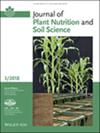Changes in Clay Mineral Composition and Soil Potassium Pools Under 50 Years of Soybean–Wheat Cropping in an Alfisol
Abstract
Background
Potassium fertilizers are imported in India, and hence, potassium fertilization is a costly input. Resource poor cultivators variably use potassium fertilization for crop production which disturbs potassium dynamics in soil impacting soil health.
Aim
A long-term negative potassium balance in the cropping system can result in the release of potassium from the non-exchangeable pool, ultimately resulting in changes in clay mineralogy, amounting to chemical degradation of soil.
Method
Soils from a long-term soybean–wheat cropping system receiving variable amounts of potassium fertilizers, which was in the 50th cropping cycle, were used to investigate the potassium pools and clay mineralogy.
Result
There was considerable reduction in yield both in control (78.7%) and 100% NP treatments (15.95%). The negative K balance followed the order 100% NP > 100% NPK > 50% NPK > 150% NPK. To meet the potassium requirement and negative potassium balances, potassium was being released from interlayers resulting in the annual loss of non-exchangeable K up to 2.42, 1.06, 0.74, and 1.34 kg ha−1 year−1 under 100% NP, Control, 50% NPK, and 100% NPK, respectively. The 100% NP treatment showed the smallest intensity of illite followed by 100% NPK, 50% NPK, Control, and 150% NPK. The illite intensity was reduced by 41.6%, 11.7%, 8.49%, and 1.6% in the 100% NP, 100% NPK, 50% NPK, and Control treatments, respectively, compared to 150% NPK.
Conclusion
The correlation studies revealed a positive association between negative balance, non-exchangeable K, and illite, supporting the hypothesis that a reduction in non-exchangeable K under negative K balances results in alterations in the clay mineralogical composition.

 求助内容:
求助内容: 应助结果提醒方式:
应助结果提醒方式:


